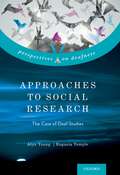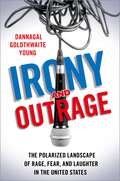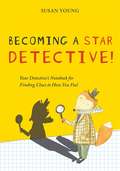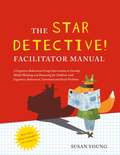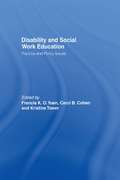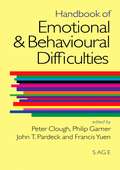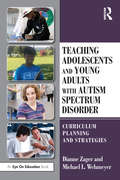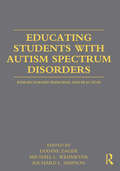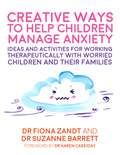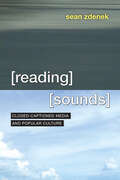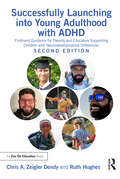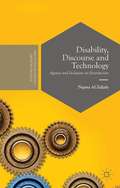- Table View
- List View
Disabling Migration Controls: Shared Learning, Solidarity, and Collective Resistance (ISSN)
by Rebecca YeoWhen people are prevented from meeting their needs, the impact is disabling, whether in the immigration system or in the wider population. Drawing on many years of research and activism, this book argues that insights from the disabled people’s movement, particularly the original Social Model of Disability, can be usefully extended to focus resistance on the disabling restrictions imposed on people subject to asylum and immigration controls.While acknowledging the pain and discomfort of many impairments and of forced displacement, the book focuses on injustices that can be changed. It does not catalogue the hostility of the ‘hostile environment’. Nor does it promote inclusive asylum restrictions. An unjust system is not transformed by including disabled people. Policies designed to deprive people of essential needs and to stoke hatred among the wider population are core elements of the rise of fascism. In this context, bringing together movements for disability and migrant justice could help build urgently needed solidarity and resistance with which to develop a society based on equity and common humanity.Quotations and images are used to convey the messages and priorities of disabled people seeking asylum, ensuring that the book is both engaging and grounded in the insights of lived experience. This book will interest people seeking to improve social justice, including scholars of disability, migration, sociology and politics.
Irony and Outrage: The Polarized Landscape of Rage, Fear, and Laughter in the United States
by Dannagal Goldthwaite YoungFor almost a decade, journalists and pundits have been asking why we don't see successful examples of political satire from conservatives or of opinion talk radio from liberals. This book turns that question on its head to argue that opinion talk is the political satire of the right and political satire is the opinion programming of the left. They look and feel like two different animals because their audiences are literally, two different animals. In Irony and Outrage, political and media psychologist Dannagal Goldthwaite Young explores the aesthetics, underlying logics, and histories of these two seemingly distinct genres, making the case that they should be thought of as the logical extensions of the psychology of the left and right, respectively. One genre is guided by ambiguity, play, deliberation, and openness, while the other is guided by certainty, vigilance, instinct, and boundaries. While the audiences for Sean Hannity and John Oliver come from opposing political ideologies, both are high in political interest, knowledge, and engagement, and both lack faith in many of our core democratic institutions. Young argues that the roles that these two genres play for their viewers are strikingly similar: galvanizing the opinion of the left or the right, mobilizing citizens around certain causes, and expressing a frustration with traditional news coverage while offering alternative sources of information and meaning. One key way in which they differ, however, concludes Young, is in their capacity to be exploited by special interests and political elites. Drawing on decades of research on political and media psychology and media effects, as well as historical accounts and interviews with comedians and comedy writers, Young unpacks satire's liberal "bias" and juxtaposes it with that of outrage's conservative "bias." She details how traits like tolerance for ambiguity and the motivation to engage with complex ideas shape our preferences for art, music, and literature; and how those same traits correlate with political ideology. In turn, she illustrates how these traits help explain why liberals and conservatives vary in the genres of political information they prefer to create and consume.
Becoming a STAR Detective!: Your Detective's Notebook for Finding Clues to How You Feel (PDF)
by Professor Susan YoungThe STAR Program is designed to teach children and those involved in their care psychological techniques to improve self-control and prosocial competence. The program employs cognitive-behavioral therapy (CBT) principles and uses a child-centered approach to teach attention skills, emotional control, problem-solving, and interpersonal skills to children aged 8-12 who have cognitive, behavioral, social or emotional difficulties. This workbook is given to the child upon joining the program with sections for each group session and individual exercises to be completed between meetings. With games, helpful tips, activities and extra space to personalize the workbook with notes and drawings, this is an essential companion for children participating in the STAR Program.
The STAR Detective Facilitator Manual: A Cognitive Behavioral Group Intervention to Develop Skilled Thinking and Reasoning for Children with Cognitive, Behavioral, Emotional and Social Problems
by Professor Susan YoungThe STAR Program is designed to teach children and those involved in their care psychological techniques to improve self-control and prosocial competence. The program employs cognitive-behavioral therapy (CBT) principles and uses a child-centered approach to teach attention skills, emotional control, problem-solving, and interpersonal skills to children aged 8-12 who have cognitive, behavioral, social or emotional difficulties. This manual includes designated group sessions to be delivered by healthcare practitioners alongside individual coaching sessions to be provided by a family member or individual carer between each group meeting. Extra materials include PowerPoint presentations, and a Thinking Tools resource, which are available to download from the JKP website.
The STAR Detective Facilitator Manual: A Cognitive Behavioral Group Intervention to Develop Skilled Thinking and Reasoning for Children with Cognitive, Behavioral, Emotional and Social Problems (PDF)
by Professor Susan YoungThe STAR Program is designed to teach children and those involved in their care psychological techniques to improve self-control and prosocial competence. The program employs cognitive-behavioral therapy (CBT) principles and uses a child-centered approach to teach attention skills, emotional control, problem-solving, and interpersonal skills to children aged 8-12 who have cognitive, behavioral, social or emotional difficulties. This manual includes designated group sessions to be delivered by healthcare practitioners alongside individual coaching sessions to be provided by a family member or individual carer between each group meeting. Extra materials include PowerPoint presentations, and a Thinking Tools resource, which are available to download from the JKP website.
Disability and Social Work Education: Practice and Policy Issues
by Francis K. O. Yuen Carol B. Cohen Kristine TowerBridging the chasm between the disabled and a just and fair society takes skill, dedication, and a deep understanding of the issues. Disability and Social Work Education: Practice and Policy Issues presents leading social work experts providing insightful, effective strategies to address the current gaps in the system between social work and those individuals with disabilities. Diverse perspectives on all levels of social work practice are integrated with the basic tenets of social justice, accessibility to services, and human rights. Specific challenges and issues are addressed in work with disabled populations. Disability and Social Work Education: Practice and Policy Issues examines the social construction of disability that connotes inferiority and highlights practical strategies for change. This creative resource gives social work educators, students, and practitioners the opportunity to embrace diverse and creative ways for integrating a generalist social work model in their work with various size systems that are related to disability. Chapters include extensive references, appendixes, tables, and figures to clearly illustrate topics. Topics in Disability and Social Work Education: Practice and Policy Issues include: model curriculum on disabilities that incorporates diverse perspectives of social work practice with individuals who have physical, cognitive, and psychiatric disabilities protecting the legal rights of children and the Individuals with Disabilities Education Act (IDEA) empowering disabled individuals for civil rights to have access to community living the academic process of helping students who are disabled achieve their academic goals components of the Americans with Disabilities Act—and key decisions made by the Supreme Court strategies of intervention for macro change historical overview of family policy and practice as it relates to children and adolescents who are disabled the biopsychosocial framework as an assessment tool to develop interventions the use of the therapeutic relationship and psychodynamic and ecological approaches to social work practices helping clients with disabilities develop adaptive religious and spiritual beliefs disability protests and movements and their implications on social work practice the Capacity Approach and the International Classification of Functioning, Disability and Health as social work tools basic guidelines for undertaking research about and with people who have disabilities Disability and Social Work Education: Practice and Policy Issues is a valuable, unique resource for social work educators, students, and practitioners.
Disability and Social Work Education: Practice and Policy Issues
by Francis K. O. Yuen Carol B. Cohen Kristine TowerBridging the chasm between the disabled and a just and fair society takes skill, dedication, and a deep understanding of the issues. Disability and Social Work Education: Practice and Policy Issues presents leading social work experts providing insightful, effective strategies to address the current gaps in the system between social work and those individuals with disabilities. Diverse perspectives on all levels of social work practice are integrated with the basic tenets of social justice, accessibility to services, and human rights. Specific challenges and issues are addressed in work with disabled populations. Disability and Social Work Education: Practice and Policy Issues examines the social construction of disability that connotes inferiority and highlights practical strategies for change. This creative resource gives social work educators, students, and practitioners the opportunity to embrace diverse and creative ways for integrating a generalist social work model in their work with various size systems that are related to disability. Chapters include extensive references, appendixes, tables, and figures to clearly illustrate topics. Topics in Disability and Social Work Education: Practice and Policy Issues include: model curriculum on disabilities that incorporates diverse perspectives of social work practice with individuals who have physical, cognitive, and psychiatric disabilities protecting the legal rights of children and the Individuals with Disabilities Education Act (IDEA) empowering disabled individuals for civil rights to have access to community living the academic process of helping students who are disabled achieve their academic goals components of the Americans with Disabilities Act—and key decisions made by the Supreme Court strategies of intervention for macro change historical overview of family policy and practice as it relates to children and adolescents who are disabled the biopsychosocial framework as an assessment tool to develop interventions the use of the therapeutic relationship and psychodynamic and ecological approaches to social work practices helping clients with disabilities develop adaptive religious and spiritual beliefs disability protests and movements and their implications on social work practice the Capacity Approach and the International Classification of Functioning, Disability and Health as social work tools basic guidelines for undertaking research about and with people who have disabilities Disability and Social Work Education: Practice and Policy Issues is a valuable, unique resource for social work educators, students, and practitioners.
Handbook of Emotional and Behavioural Difficulties (PDF)
by Professor Francis Yuen Professor John T Pardeck Professor Peter Clough Professor Philip Garner`At first glance I felt that this is a book that I should buy. On reading a selection of the chapters I realized that I must buy it. Each of the four sections has chapter that I know I will want to read and many others that I will read. It is a book that will provide student and authors in Higher Education and practitioners with much food for thought. It also emphasizes the desperate need to cut through much of the polemic that abounds in this field and to return to argument based on carefully conducted empirical work’ - Harry Daniels, Deputy Head of School and Director of Research, School of Education, University of Birmingham `Emotional and Behavioural Difficulties (EBD) in schools can be defined in many ways. For example, EBD can be seen as: a set of problems that reside mainly within the individual student; as the result of interactions between social and psychological sub-systems, or as the product of professional discourses that create and maintain the very problems that they purport to identify and solve. Clough and Garner's Handbook of Emotional and Behavioural Difficulties sheds light on all of these perspectives and reveals the enormous complexity and diversity of what is termed "EBD". In doing this, the book reveals itself to be both a scholarly and practical resource that will be indispensable to anyone seeking insight and direction for understanding and responding to EBD in the 21st century. Readers looking for off the cuff 'tips for teachers' or simplistic solutions will not find what they want in this book. Rather, the Handbook of Emotional and Behavioural Difficulties will appeal to readers who want to hear from writers who have genuine insight into the multi-faceted world of EBD, who have worthwhile things to say about the range of possible solution to this area of difficulty, and, regardless of differences that might appear between their theoretical positions, share a sense of deep compassion for needs of students and educational professionals who experience EBD on day-to-day basis' - Professor Paul Cooper, The University of Leicester The behaviour of children in primary and secondary schools has been a consistent source of interest and controversy since the 19th century. Some commentators suggest that the phenomenon has a far more impressive historical pedigree. As education systems in First World democracies struggle to meet changing social, economic and educational conditions, one group of children has increasingly become the focus of attention. These are those who, for a variety of underpinning reasons, are either unable or unwilling to conform to the requirements of formal schooling. As a result they are identified as having Emotional and/or Behavioural Difficulties (EBDs) of one level of severity or another. Contemporary debate increasingly links causation with intervention, to form a holistic approach to problem prevention or remediation.
Teaching Adolescents and Young Adults with Autism Spectrum Disorder: Curriculum Planning and Strategies
by Dianne Zager Michael L. WehmeyerTeaching Adolescents and Young Adults with Autism Spectrum Disorder supports teachers in preparing secondary students with autism spectrum disorder (ASD) to succeed in school, work and beyond. Focused on enabling students to successfully pursue further education and meaningful career paths, chapters incorporate person-centered, student-directed planning into instructional programming throughout the text. Featuring helpful vignettes to demonstrate concepts in action, curriculum areas address community living skills, academics, social communication and interaction, and career preparation. Grounded in current research and Universal Design for Learning practices, this guide is an essential resource for educators, therapists, and anyone seeking to create fluid, adaptable programs for students with autism spectrum disorders.
Teaching Adolescents and Young Adults with Autism Spectrum Disorder: Curriculum Planning and Strategies
by Dianne Zager Michael L. WehmeyerTeaching Adolescents and Young Adults with Autism Spectrum Disorder supports teachers in preparing secondary students with autism spectrum disorder (ASD) to succeed in school, work and beyond. Focused on enabling students to successfully pursue further education and meaningful career paths, chapters incorporate person-centered, student-directed planning into instructional programming throughout the text. Featuring helpful vignettes to demonstrate concepts in action, curriculum areas address community living skills, academics, social communication and interaction, and career preparation. Grounded in current research and Universal Design for Learning practices, this guide is an essential resource for educators, therapists, and anyone seeking to create fluid, adaptable programs for students with autism spectrum disorders.
Educating Students with Autism Spectrum Disorders: Research-Based Principles and Practices
by Dianne Zager Michael L. Wehmeyer Richard L. SimpsonSimilar to a handbook in its comprehensive description of the theory and research supporting current practices in the treatment of autism spectrum disorders, this interdisciplinary text shows how the existing knowledge base can be used to explore promising new possibilities related to the field’s many unanswered questions. Key features include the following: Comprehensive – This is the first book to consider the history and current state of autism as a field in transition, to cover its varied approaches and philosophies, and to describe the interventions used throughout the developmental cycle. Cross Disciplinary – Serving students with autism necessitates communication and collaboration among professionals from several disciplines as well as family members. The editors have, therefore, brought together divergent perspectives, theories and philosophies in order to demonstrate that scientific evidence, rather than educational orientation, must determine which practices should be selected for use in particular situations. Research Based – Whereas many existing texts advocate a particular type of treatment, this one recognizes that interventions must be selected and evaluated based on the scientific evidence of their effectiveness. Integrated Methodology –Chapter authors consider findings from studies that employed single-subject designs, experimental large-scale studies, and qualitative methodology. The inter-relatedness of therapies and disciplines will be highlighted throughout. Expertise – The volume editors are all highly visible researchers in autism and developmental disabilities. Likewise, each chapter is directed by a senior, highly accomplished author who is nationally recognized for his/her work in the topic being addressed. This book is appropriate for practicing professionals in education and psychology and for speech/language therapists and other clinicians. It is also suitable as a graduate level text in these fields.
Educating Students with Autism Spectrum Disorders: Research-Based Principles and Practices
by Dianne Zager Michael L. Wehmeyer Richard L. SimpsonSimilar to a handbook in its comprehensive description of the theory and research supporting current practices in the treatment of autism spectrum disorders, this interdisciplinary text shows how the existing knowledge base can be used to explore promising new possibilities related to the field’s many unanswered questions. Key features include the following: Comprehensive – This is the first book to consider the history and current state of autism as a field in transition, to cover its varied approaches and philosophies, and to describe the interventions used throughout the developmental cycle. Cross Disciplinary – Serving students with autism necessitates communication and collaboration among professionals from several disciplines as well as family members. The editors have, therefore, brought together divergent perspectives, theories and philosophies in order to demonstrate that scientific evidence, rather than educational orientation, must determine which practices should be selected for use in particular situations. Research Based – Whereas many existing texts advocate a particular type of treatment, this one recognizes that interventions must be selected and evaluated based on the scientific evidence of their effectiveness. Integrated Methodology –Chapter authors consider findings from studies that employed single-subject designs, experimental large-scale studies, and qualitative methodology. The inter-relatedness of therapies and disciplines will be highlighted throughout. Expertise – The volume editors are all highly visible researchers in autism and developmental disabilities. Likewise, each chapter is directed by a senior, highly accomplished author who is nationally recognized for his/her work in the topic being addressed. This book is appropriate for practicing professionals in education and psychology and for speech/language therapists and other clinicians. It is also suitable as a graduate level text in these fields.
Creative Ways to Help Children Manage BIG Feelings: A Therapist's Guide to Working with Preschool and Primary Children (PDF)
by Dr Fiona Zandt Dr Lesley Bretherton Dr Suzanne BarrettTo be able to effectively offer therapy to children, complex therapeutic concepts need to be presented in an appropriate and engaging manner. This practical guide provides clinicians with a way in which to do so, with numerous games and imaginative activities to help children aged 4-12 to express and understand their feelings. Part I provides a comprehensive guide to working therapeutically with children and families, while Part II outlines 47 creative therapeutic activities. Each activity is presented with clear instructions using inexpensive and readily available resources and the objective and rationale of each activity is given, making it easily applicable. Activities range from using an easy to make volcano to help children better understand anger, to using a ball of string to illustrate how one person's feelings affect the whole family. This book is an invaluable resource for newly qualified clinicians, and also a treasure trove of creative ideas for experienced therapists.
Creative Ways to Help Children Manage Anxiety: Ideas and Activities for Working Therapeutically with Worried Children and Their Families
by Fiona Zandt Suzanne BarrettPacked full of ways to make therapeutic concepts engaging for children, this book contains over 50 therapeutic activities for managing anxiety with children aged 4-12. With guidance on how to approach work with children, and activities that use only readily available materials, it is an ideal guide for both experienced and newly qualified professionals.
Reading Sounds: Closed-Captioned Media and Popular Culture
by Sean ZdenekImagine a common movie scene: a hero confronts a villain. Captioning such a moment would at first glance seem as basic as transcribing the dialogue. But consider the choices involved: How do you convey the sarcasm in a comeback? Do you include a henchman’s muttering in the background? Does the villain emit a scream, a grunt, or a howl as he goes down? And how do you note a gunshot without spoiling the scene? These are the choices closed captioners face every day. Captioners must decide whether and how to describe background noises, accents, laughter, musical cues, and even silences. When captioners describe a sound—or choose to ignore it—they are applying their own subjective interpretations to otherwise objective noises, creating meaning that does not necessarily exist in the soundtrack or the script. Reading Sounds looks at closed-captioning as a potent source of meaning in rhetorical analysis. Through nine engrossing chapters, Sean Zdenek demonstrates how the choices captioners make affect the way deaf and hard of hearing viewers experience media. He draws on hundreds of real-life examples, as well as interviews with both professional captioners and regular viewers of closed captioning. Zdenek’s analysis is an engrossing look at how we make the audible visible, one that proves that better standards for closed captioning create a better entertainment experience for all viewers.
Reading Sounds: Closed-Captioned Media and Popular Culture
by Sean ZdenekImagine a common movie scene: a hero confronts a villain. Captioning such a moment would at first glance seem as basic as transcribing the dialogue. But consider the choices involved: How do you convey the sarcasm in a comeback? Do you include a henchman’s muttering in the background? Does the villain emit a scream, a grunt, or a howl as he goes down? And how do you note a gunshot without spoiling the scene? These are the choices closed captioners face every day. Captioners must decide whether and how to describe background noises, accents, laughter, musical cues, and even silences. When captioners describe a sound—or choose to ignore it—they are applying their own subjective interpretations to otherwise objective noises, creating meaning that does not necessarily exist in the soundtrack or the script. Reading Sounds looks at closed-captioning as a potent source of meaning in rhetorical analysis. Through nine engrossing chapters, Sean Zdenek demonstrates how the choices captioners make affect the way deaf and hard of hearing viewers experience media. He draws on hundreds of real-life examples, as well as interviews with both professional captioners and regular viewers of closed captioning. Zdenek’s analysis is an engrossing look at how we make the audible visible, one that proves that better standards for closed captioning create a better entertainment experience for all viewers.
Reading Sounds: Closed-Captioned Media and Popular Culture
by Sean ZdenekImagine a common movie scene: a hero confronts a villain. Captioning such a moment would at first glance seem as basic as transcribing the dialogue. But consider the choices involved: How do you convey the sarcasm in a comeback? Do you include a henchman’s muttering in the background? Does the villain emit a scream, a grunt, or a howl as he goes down? And how do you note a gunshot without spoiling the scene? These are the choices closed captioners face every day. Captioners must decide whether and how to describe background noises, accents, laughter, musical cues, and even silences. When captioners describe a sound—or choose to ignore it—they are applying their own subjective interpretations to otherwise objective noises, creating meaning that does not necessarily exist in the soundtrack or the script. Reading Sounds looks at closed-captioning as a potent source of meaning in rhetorical analysis. Through nine engrossing chapters, Sean Zdenek demonstrates how the choices captioners make affect the way deaf and hard of hearing viewers experience media. He draws on hundreds of real-life examples, as well as interviews with both professional captioners and regular viewers of closed captioning. Zdenek’s analysis is an engrossing look at how we make the audible visible, one that proves that better standards for closed captioning create a better entertainment experience for all viewers.
Reading Sounds: Closed-Captioned Media and Popular Culture
by Sean ZdenekImagine a common movie scene: a hero confronts a villain. Captioning such a moment would at first glance seem as basic as transcribing the dialogue. But consider the choices involved: How do you convey the sarcasm in a comeback? Do you include a henchman’s muttering in the background? Does the villain emit a scream, a grunt, or a howl as he goes down? And how do you note a gunshot without spoiling the scene? These are the choices closed captioners face every day. Captioners must decide whether and how to describe background noises, accents, laughter, musical cues, and even silences. When captioners describe a sound—or choose to ignore it—they are applying their own subjective interpretations to otherwise objective noises, creating meaning that does not necessarily exist in the soundtrack or the script. Reading Sounds looks at closed-captioning as a potent source of meaning in rhetorical analysis. Through nine engrossing chapters, Sean Zdenek demonstrates how the choices captioners make affect the way deaf and hard of hearing viewers experience media. He draws on hundreds of real-life examples, as well as interviews with both professional captioners and regular viewers of closed captioning. Zdenek’s analysis is an engrossing look at how we make the audible visible, one that proves that better standards for closed captioning create a better entertainment experience for all viewers.
Reading Sounds: Closed-Captioned Media and Popular Culture
by Sean ZdenekImagine a common movie scene: a hero confronts a villain. Captioning such a moment would at first glance seem as basic as transcribing the dialogue. But consider the choices involved: How do you convey the sarcasm in a comeback? Do you include a henchman’s muttering in the background? Does the villain emit a scream, a grunt, or a howl as he goes down? And how do you note a gunshot without spoiling the scene? These are the choices closed captioners face every day. Captioners must decide whether and how to describe background noises, accents, laughter, musical cues, and even silences. When captioners describe a sound—or choose to ignore it—they are applying their own subjective interpretations to otherwise objective noises, creating meaning that does not necessarily exist in the soundtrack or the script. Reading Sounds looks at closed-captioning as a potent source of meaning in rhetorical analysis. Through nine engrossing chapters, Sean Zdenek demonstrates how the choices captioners make affect the way deaf and hard of hearing viewers experience media. He draws on hundreds of real-life examples, as well as interviews with both professional captioners and regular viewers of closed captioning. Zdenek’s analysis is an engrossing look at how we make the audible visible, one that proves that better standards for closed captioning create a better entertainment experience for all viewers.
Reading Sounds: Closed-Captioned Media and Popular Culture
by Sean ZdenekImagine a common movie scene: a hero confronts a villain. Captioning such a moment would at first glance seem as basic as transcribing the dialogue. But consider the choices involved: How do you convey the sarcasm in a comeback? Do you include a henchman’s muttering in the background? Does the villain emit a scream, a grunt, or a howl as he goes down? And how do you note a gunshot without spoiling the scene? These are the choices closed captioners face every day. Captioners must decide whether and how to describe background noises, accents, laughter, musical cues, and even silences. When captioners describe a sound—or choose to ignore it—they are applying their own subjective interpretations to otherwise objective noises, creating meaning that does not necessarily exist in the soundtrack or the script. Reading Sounds looks at closed-captioning as a potent source of meaning in rhetorical analysis. Through nine engrossing chapters, Sean Zdenek demonstrates how the choices captioners make affect the way deaf and hard of hearing viewers experience media. He draws on hundreds of real-life examples, as well as interviews with both professional captioners and regular viewers of closed captioning. Zdenek’s analysis is an engrossing look at how we make the audible visible, one that proves that better standards for closed captioning create a better entertainment experience for all viewers.
Successfully Launching into Young Adulthood with ADHD: Firsthand Guidance for Parents and Educators Supporting Children with Neurodevelopmental Differences
by Chris A. Zeigler Dendy Ruth HughesThis new edition of Successfully Launching into Young Adulthood with ADHD provides firsthand guidance for both parents and professionals to help teens prepare for a bright future after high school. The advice and strategies outlined in this book are evidence based and provide much-needed guidance to parents and the professionals who educate, coach and treat these students. This guidance will ensure that teens are ready to meet upcoming challenges and demands after high school graduation. With an always hopeful and personable message, the authors share their own and other parents’ insights on avoiding common missteps, the perils of a premature launch to college and finding what works for their unique child. Updated chapters include a discussion around medications and new information on gap year programs, and college accommodations. This top-notch guide is essential reading for any parent raising a young adult with ADHD and for the professionals who work with them.
Successfully Launching into Young Adulthood with ADHD: Firsthand Guidance for Parents and Educators Supporting Children with Neurodevelopmental Differences
by Chris A. Zeigler Dendy Ruth HughesThis new edition of Successfully Launching into Young Adulthood with ADHD provides firsthand guidance for both parents and professionals to help teens prepare for a bright future after high school. The advice and strategies outlined in this book are evidence based and provide much-needed guidance to parents and the professionals who educate, coach and treat these students. This guidance will ensure that teens are ready to meet upcoming challenges and demands after high school graduation. With an always hopeful and personable message, the authors share their own and other parents’ insights on avoiding common missteps, the perils of a premature launch to college and finding what works for their unique child. Updated chapters include a discussion around medications and new information on gap year programs, and college accommodations. This top-notch guide is essential reading for any parent raising a young adult with ADHD and for the professionals who work with them.
Disability, Discourse and Technology: Agency and Inclusion in (Inter)action
by Najma Al ZidjalyExclusion is the main predicament faced by people with disabilities across contexts and cultures, yet it is one of the least academically studied concepts. This book brings together past and new research to offer an applied linguistics perspective on timely critical issues in disability research, filling in a number of gaps in discourse analysis and disability studies. Through analysis of various types of data collected as part of a longitudinal, ethnographic case study involving one MuslimArab man with disability and members of his social circles, the book presents a new framework for the analysis of agency and inclusion in inter(action). The book illustrates the necessity of going beyond bounded texts when dealing with identities constructed by individuals with disabilities and the need to deconstruct taken-for-granted binary categories of what does and does not constitute disability and ability. It further documents the role that a seemingly dependent agent can play, in conjunction with caregivers, in combating the marginalization afforded to him or her by certain disability ideologies. On top of this, the book offers insight into how to conduct multimodal research that is empirically rigorous, theoretically grounded, socioculturally sensitive, and activism-oriented.
Disability, Discourse And Technology: Agency and Inclusion in (Inter)action (PDF)
by Najma Al ZidjalyExclusion is the main predicament faced by people with disabilities across contexts and cultures, yet it is one of the least academically studied concepts. This book brings together past and new research to offer an applied linguistics perspective on timely critical issues in disability research, filling in a number of gaps in discourse analysis and disability studies. Through analysis of various types of data collected as part of a longitudinal, ethnographic case study involving one MuslimArab man with disability and members of his social circles, the book presents a new framework for the analysis of agency and inclusion in inter(action). The book illustrates the necessity of going beyond bounded texts when dealing with identities constructed by individuals with disabilities and the need to deconstruct taken-for-granted binary categories of what does and does not constitute disability and ability. It further documents the role that a seemingly dependent agent can play, in conjunction with caregivers, in combating the marginalization afforded to him or her by certain disability ideologies. On top of this, the book offers insight into how to conduct multimodal research that is empirically rigorous, theoretically grounded, socioculturally sensitive, and activism-oriented.

